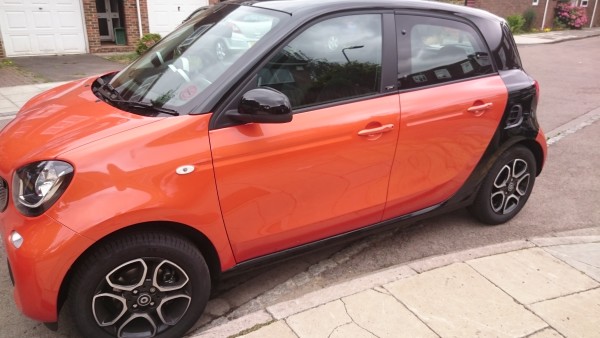At the end of last year I had a chance to try out the newly remodelled Smart Car and I was impressed with it. However, since it was a press trip I was given more time with the Smart ForTwo then the ForFour – I liked the latter more than the former, but I didn’t get much time with it. Thankfully the folks at Smart were kind enough to loan me a ForFour for a week so that I could get a much closer look, and really experience it.
This new Smart has been designed by Mercedes, who now own the brand, and shares a lot of its parts and structure with the Renault Twingo. The two tone colour scheme is a flashback to the old model, but otherwise it looks much better. The shape has been altered to give it a stronger look, the lights designed, and a honeycomb front grill added. The colour options vary – I had the black and gold, but there’s a variety of different schemes depending on which package you go for. The interior has also had a revamp; it matches the exterior the pebble touchscreen console proved to be very popular amongst my crowd, although I wasn’t so keen on the old school A/C controls. A colour screen next to the speedometer provides a wealth of driving stats, and information on the car.
Optional extras include a rear view camera for reversing, USB and SD Card slots for music and Sat Nav, a JBL sound system, automatic wipers, and a few other smaller features such as heated side mirrors.
One change that Smart have implemented with this model is the possibility of increased boot space. The standard rectangular space is enough for a few shopping bags, but it’s also possible to fold the back seats down to add some much needed storage capacity.
Engine wise there are two options – the 71bhp version, or the 90bhp version. Both come with automatic stop start as standard, which switches the engine off when stationary, and both also come under the 100g/km CO2 emission mark, making the car exempt from road tax. I wasn’t able to try the 71bhp version but have heard that it can be a little sluggish. However, the 90bhp engine is only £600 more, so if you’re already committed to buying a car, that extra cost isn’t a huge difference. The fuel economy tops out at an impressive 67mpg on the 71bhp, and 67.3mpg on the 90bhp.
After a week with the ForFour, I had a lot of positive impressions. I spent a total of roughly 8 hours and around 100 miles in the car, negotiating various areas of London at different times of the day, and I couldn’t find a fault with it’s performance. When I gave it back I hadn’t even used a quarter of the tank, indicating that if I owned it I could legitimately go for a couple of months without needing to fill up the tank.
The car also drives well. I had an inkling of it before, but once I got a hold of it, the practicality of it surprised me. The turning circle is slightly less than the ForTwo, and of a London taxi, but only just, and I didn’t do a single three point turn all week; a full lock of the steering wheel was enough to get me pointing in the right direction. With this sensitivity, it does take a while to get used to the steering, but unlike the ForTwo, which can feel a bit like a go kart, the extra weight and length of the ForFour adds a nice counterbalance which keeps the car stable.
In the city it doesn’t feel short for acceleration, but on more open roads and motorways it needs some skilful manipulation of the gears to get the best out of it. Those who aren’t fussed about this might feel that the automatic would be a better option, but for the more experienced drivers who have no qualms driving a manual, this wouldn’t be a problem. It also feels stable and firm at higher speeds.
Mercedes have made it clear that safety was one of their main priorities when designing the new Smart, and this is quite evident. The new design has improved impact absorption, and also had a number of features added on (some optional): electronic stability control to stop the car spinning on wet roads, crosswind assistance, which prevents buffeting from strong winds, a lane assist system than beeps when you veer out of lane, and a forward collision warning system, which can detect potential oncoming impacts and warn the driver.
After my time with it, I was quite sad to give it back. It was an enjoyable drive, with good handling and even better fuel economy. When I was carrying passengers or seeing friends, many of them them were impressed with the design, and expressed interest in getting their own one, which is a testament to the quality of this new line up.
Price wise, with the fully loaded version topping out at just under £15k, it’s around £2k more expensive than it’s direct competitors, such as the Hyundai i10 and the aforementioned Twingo, however it boasts lower running costs thanks the low emission and fuel economy. Style wise, it’s a definitely the leader in the field, both inside and outside. As with previous models, it’s possible to customise these to your liking – a more economical version of the car with a good chunk of extras and the 90bhp engine can be had for £12-13k, which is a reasonable price. Ultimately it will boil down to how much a consumer is willing to pay – for Mercedes quality at a good price, the Smart is a very attractive option.











